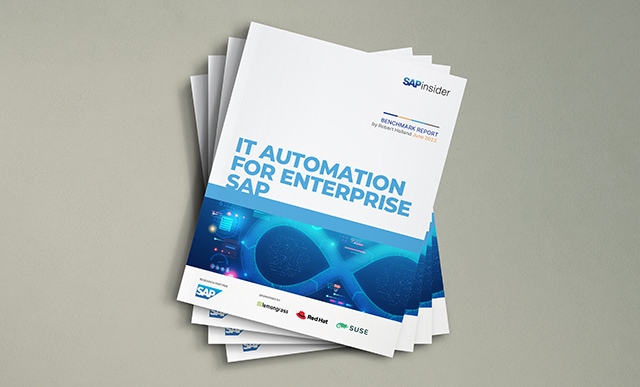Future-Proofing and Scaling Workload Automation with RunMyJobs by Redwood Software
Meet the Authors
Key Takeaways
⇨ Traditional automation methods and cloud solutions are becoming inadequate for the changing IT and business environments.
⇨ Organizations need to ensure their automation initiatives enable innovation and adaptability to evolving business needs.
⇨ Redwood Software offers a comprehensive range of IT solutions, focusing on workload automation and file transfer to provide complete business process automation end-to-end.
The acceleration of digital transformation and cloud adoption post-pandemic has necessitated a corresponding rapid evolution in workload automation tool (WLA), more advanced automation than traditional job scheduling that many SAP customers are familiar with. Traditional automation methods and cloud solutions are becoming inadequate for the changing IT and business environments. While streamlining IT operations offers a competitive edge, complexities pose significant challenges like delayed outcomes that hinder digital transformation. Organizations need to ensure their automation initiatives enable innovation and adaptability to evolving business needs. However, while identifying optimal starting points and potential areas for expansion is key, integrating tools across both on-premise and cloud-based systems is essential. Equally important is reducing adoption barriers for both IT teams and business users to facilitate a smooth and effective digital transition.
Redwood Software offers a comprehensive range of IT solutions, focusing on workload automation and file transfer to provide complete business process automation end-to-end.
Workload automation offerings include three products: Tidal, ActiveBatch and their flagship enterprise solution, RunMyJobs. RunMyJobs is a full stack enterprise job scheduler and batch processor that automates mission-critical processes in complex computing environments for your SAP and non-SAP tech stack.
Two file transfer products round out Redwood’s offerings: JSCAPE, a managed file transfer solution, and Cerberus, a secure SFTP solution. While file transfer involves securely moving files and handling EDI, essential for data exchange with external parties, the process is crucial for securely transmitting sensitive data to governance authorities or suppliers. Redwood’s mission in the file transfer business is clear: to empower organizations with secure, dependable, flexible and powerful file transfer solutions scalable for the modern digital enterprise.
On the other hand, workload automation, distinct from RPA and other automation technologies, handles complex, long-running processes that operate autonomously, like purchase-to-pay, record-to-report, billing processes and production planning. The technology enables companies to compose automation with a low-code, drag-and-drop editor and a library of pre-built templates, provides end-to-end visibility from a single pane of glass with progressions and warnings, and automates with guaranteed 99.95% SaaS uptime and best-in-class security.
As Devin Gharibian-Saki, Senior Vice President Business Development & Strategy, Redwood Software says, “Automation involves handling intricate and extensive processes designed to operate without human intervention. It is intended to function autonomously in the background, performing essential data management tasks necessary for an IT system’s smooth operation. This includes processes like billing, invoicing, production planning and marketing planning – tasks that require substantial data processing and transfer from one point to another. The goal is to ensure these processes occur seamlessly and frequently without interruptions. Technologies like ours are dedicated to ensuring these vital business processes are executed reliably and efficiently.”
Solution Segmentation
Redwood’s customer base is segmented into mid-market and enterprise categories, each with unique needs. While mid-market customers usually require automation tools for their growing and complex processes, enterprise customers, often amidst major IT transformations, seek Redwood’s SaaS solutions like RunMyJobs for their cloud strategies. Redwood aims to simplify automation technology in these complex IT environments. “Mid-market customers often have core systems like ERPs and BI tools but lack dedicated automation solutions. As their processes become too complex for these basic systems, they seek specialized tools to manage this growth. This is a typical scenario for mid-market customers whose needs evolve as they expand. On the other hand, enterprise customers deal with more intricate IT setups, involving multiple ERPs, BI systems and various platforms. They often face transformations, like migrating to SAP S/4HANA or Oracle Fusion, requiring a simplification of their complex IT landscape, including automation technologies. Redwood offerings, particularly our unique SaaS solution, RunMyJobs, align with the cloud strategies of these large organizations, making us a preferred partner for both mid-market and enterprise customers seeking to streamline and manage their growing IT and automation needs,” comments Gharibian-Saki.
Tracking with SAP Roadmap
Redwood prioritizes co-developing and aligning their products with SAP’s roadmap, a crucial strategy as the majority of Redwood’s RunMyJobs customers are committed to SAP or Oracle ecosystems. This alignment is especially important in today’s IT landscape, which is moving towards cloud ERPs and becoming increasingly complex. “Many companies have strategically invested in SAP or Oracle and these ERP systems are the backbone of their business. Therefore, Redwood ensures thatour products are seamlessly in sync with the roadmaps of these major ERP providers for optimal performance and limitless scalability,” says Gharibian-Saki.
Legacy products, designed as monolithic job schedulers for mainframe systems, struggle in the new cloud environment, revealing their architectural limitations. This is prompting many organizations to switch from legacy systems offered by BMC, IBM and Broadcom to Redwood’s RunMyJobs. RunMyJobs’ architecture is fundamentally different. It is a native SaaS platform, centralized and agent-less, offering scalability and lightweight operation without relying on rigid day-plans. The platform allows real-time orchestration, making it more suitable for the hybrid cloud and cloud ERP environments.
A case in point is Energizer’s transition from ECC to SAP S/4HANA. Redwood facilitated this shift by seamlessly integrating old and new systems, using native SAP connectors which eliminated the need for custom coding and ensured uninterrupted production planning. Another example is Grainger, which lacked an automation platform before collaborating with Redwood. The partnership drastically reduced their order-to-cash cycle time from 36 to 6 hours, enabling next-day deliveries and expanding their business opportunities, including contracts with the U.S. government.
When engaging with new clients, Redwood’s approach varies. For greenfield customers, the focus is on the potential time savings and process improvements, such as the impact of faster order-to-cash cycles. For those replacing legacy systems, the company conducts a Total Cost of Ownership (TCO) analysis and set migration success as a primary KPI, often providing a migration guarantee to ensure a smooth transition to a Redwood platform.
As Gharibian-Saki explains, “Often, our clients are using a competitor’s product that is due for renewal. In such cases, our goal and key performance indicator is to transition them from their current system to RunMyJobs by Redwood within 12 months, ensuring uninterrupted operations on a new platform. This migration becomes a central focus in our discussions. We are committed to what we call a ‘migration guarantee’, emphasizing the importance of our customers’ confidence in achieving this transition smoothly. Alongside our systematic approach for migration, we aim to reassure our clients of our capability to successfully manage this change.”
AI and ML integration
RunMyJobs leverages AI as an automation tool and integrates it within its orchestration layer, enhancing the capabilities of its products to manage and streamline data flows, crucial for consistent business operations. This integration not only supports various AI technologies, like chat GPTs or AWS’s text analysis tools, but also bolsters the value the company delivers to its customers. Gharibian-Saki says, “We’re exploring AI’s potential to simplify user interactions with our products, such as accelerating and optimizing process flows, thereby improving efficiency and ease of use for our customers. For instance, we can incorporate and utilize machine learning algorithms as a part of our process. An example of this would be orchestrating data flow into an AI tool for tasks like image recognition, determining whether an image depicts a dog or a cat. We ensure our product supports various AI technologies, from chatbots to text analysis tools from AWS or Google, integrating these AI functions seamlessly.”
RunMyJobs’ automation capabilities also play a significant role in managing data flows, ensuring consistency and reliability, which are essential for effective AI functioning. The company is also using AI to simplify the use of its products for clients, which includes using AI to accelerate process flows within the products or optimizing them for efficiency, like reducing the cycle time in production planning processes.
Integrating AI into its development strategy, Redwood is concentrating on four main areas:
User Experience Enhancement: Continually improving platforms to simplify configuration, operation and monitoring for users.
Automation at Scale: Expanding the connector library and integrations to support new technologies and applications, ensuring scalable operations for customers with solutions like SAP, Oracle, Snowflake and Databricks.
Cloud Leadership: Strengthening market leadership in cloud performance through ongoing enhancements and advancements.
Intelligent Automation Integration: Incorporating AI and machine learning to augment workload automation offerings. As Gharibian-Saki puts forth, “We are focusing on four key areas in our development strategy. First, we are dedicated to enhancing the user experience of our platforms, striving to simplify the process of configuring, running and monitoring for our users. Secondly, we are expanding our ‘automation at scale’ initiative. This involves developing new connectors and integrations, as well as supporting emerging technologies and applications. Whether it is for the latest SAP or Oracle product, or other providers like Snowflake or Databricks, we are committed to continually enhancing our connector library. This ensures our customers can scale their operations without limitations. The third focus is on our cloud platform. We aim to not only maintain but also enhance our position as market leaders in cloud performance. This involves continuous improvements and additions to our cloud capabilities. Lastly, we are integrating intelligent automation into our offerings. This includes incorporating AI and machine learning to support and enhance our products, particularly in workload automation. For managed file transfer, the priorities differ slightly. Here, security and compliance are of paramount importance. Although these aspects are crucial in our automation products, they are even more emphasized in managed file transfer, reflecting the unique needs and concerns in this area.”
What this means for SAPinsiders?
End-to-end automation optimization: Avoid relying solely on a simple automation tool like RPA for repetitive tasks and data entry. While RPA excels in automating discrete tasks for individual users, many companies will benefit from orchestrating complex processes end-to-end across their entire tech stack with easy to use pre-built connectors and APIs. A well-rounded automation strategy takes into account all organizational needs and how to efficiently run and scale.
Greater control, collaboration and visibility: Tackle the disconnect between IT and business units while dealing with the multitude of applications and systems. Often, business units may implement individual new technology and automations offerings that run independently, leading to building siloes and complexities with increased costs down the line. All business process automations visible from a single pane of glass gives IT more control and insights while improving collaboration and understanding between IT and individual business units. The result of better alignment and more effective automation strategies is vast improvement in how automation efforts drive business outcomes.








